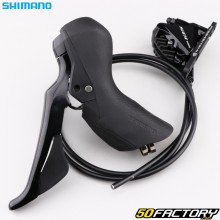 Complete brake
Complete brake
 Complete brake
Complete brake
- IN STOCK303€70
- IN STOCK303€70
Understanding the complete brake for gravel and cyclocross
Definition and importance
Un complete brake for gravel and cyclocross consists of several components working together to provide effective braking. These components include calipers, rotors, pads, and brake fluid. These components are designed to withstand the harsh conditions often encountered in gravel and cyclocross riding.cross, such as mud, water, and rough terrain. A quality complete brake is essential to ensure the safety of the cyclist and optimize their performance.
Disc braking vs rim braking
Disc brakes and rim brakes are the two main types of braking systems used in gravel and cyclocross.cross.
Disc brakes: This type of braking uses metal discs attached to the wheel hubs and calipers that pinch the discs to slow or stop the bike. Disc brakes are known for their superior stopping power and consistent performance in all weather conditions. They are also less prone to mud buildup and offer better modulation.
Rim braking: Traditionally used on road bikes, rim brakes pinch the sidewalls of the rims to slow the bike. While they are lighter and often less expensive, their performance can be affected byar mud and water, making braking less reliable in difficult conditions.
The different components of the complete brake
Brake calipers
Brake calipers are the components that pinch the pads against the discs to create the friction needed for braking. They can be mechanical or hydraulic. Hydraulic calipers offer more precise modulation and greater stopping power through the transmission of force via brake fluid. Mechanical calipers, on the other hand, are easier to maintain and adjust.
Brake discs
Brake discs, also known as rotors, are metal disks that are attached to the hubs of wheels. They typically range in size from 140mm to 180mm, with larger discs offering increased stopping power and better heat dissipation. They are often made of stainless steel to resist corrosion and provide maximum durability.
Brake pads
Brake pads are the friction surfaces that come into contact with the rotors to create braking. They can be made of resin, sintered metal, or ceramic. Resin pads are softer and provide quiet braking, but wear out more quickly. Sintered metal pads are more durable and perform better in wet conditions, while ceramic pads offer exceptional modulation and long life.
brake fluid
Brake fluid is used in hydraulic braking systems to transmit the force from the brake lever to the calipers. It must be of high quality and able to withstand high temperatures without vaporizing. DOT (Department of Transportation) brake fluid and mineral fluid are the two commonly used types. DOT fluid has a higher boiling point, while mineral fluid offers easier maintenance and is less corrosive.
Criteria for choosing a complete brake
Choose according to the type of bike
Choosing a complete brake for gravel or cyclocross must first take into account the type of bike used. Gravel and cyclo bikescross have specific braking requirements due to their varied and often difficult terrain. Disc brakes are generally preferred for these types of bikes due to their reliable performance in muddy and wet conditions.
Choose according to driving style
Your riding style also influences the choice of brakes. If you are racing or looking for maximum performance, hydraulic disc brakes with larger rotors and sintered metal pads may be the best option. For more recreational use or for beginners, mechanical disc brakes or resin pads may be sufficient.
Choose according to the brand
Brands play an important role in choosing complete brakes. Shimano and SRAM are two of the most recognized brands for their reliable and high-performance braking systems. The components of these brands are often compatible with each other and offer a wide range of options to meet different needs and budgets.
How to optimize the performance of your brake
Gravel and cyclo braking techniquescross
Braking techniques are crucial to optimizing the performance of your complete brakes. It is important to brake progressively and avoid sudden braking that can cause the wheels to lock and lose control. Use the front brake primarily for its power, while applying the rear brake to stabilize the bike. On technical descents, adopt a more rearward position on the bike to improve traction and control.
When to change brake pads
Brake pads should be replaced when they show signs of excessive wear. A good rule of thumb is to check the thickness of the pads. If they are less than 1 mm, it is time to replace them. Worn pads can reduce braking efficiency and damage the rotors. Also listen for unusual noises when braking, such as squealing or whistling, which can indicate advanced wear.
Care instructions
Caliper Maintenance
Calipers should be cleaned regularly to prevent the buildup of mud and debris that can affect their performance. Use a soft brush and soapy water to clean the calipers. Also check the pistons and make sure they move freely. Lubricate the seals and pistons with a lubricant compatible with the brake system.
Disk Maintenance
Brake discs should be cleaned with a specific brake cleaner to remove oil and dirt residue. Avoid using harsh chemicals that could damage the discs. Inspect the discs regularly for signs of wear or warping and replace them if necessary.
Maintenance of the pads
The pads should be inspected and cleaned regularly. Remove them from the calipers and clean the friction surfaces with fine sandpaper to remove brake deposits. Replace the pads if they are excessively worn or damaged. Also make sure the pads are properly aligned and centered par report to the disks.
Brake Fluid Maintenance
Brake fluid should be bled and replaced regularly to maintain optimum performance. Follow the manufacturer's recommendations for replacement frequency. Use a high-quality brake fluid that is compatible with your brake system. Bleed the system to remove air bubbles that can affect braking performance.







































